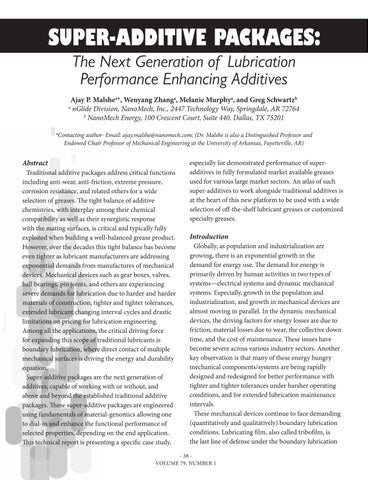SUPER-ADDITIVE PACKAGES: The Next Generation of Lubrication Performance Enhancing Additives a
Ajay P. Malshea*, Wenyang Zhanga, Melanie Murphya, and Greg Schwartzb nGlide Division, NanoMech, Inc., 2447 Technology Way, Springdale, AR 72764 b NanoMech Energy, 100 Crescent Court, Suite 440, Dallas, TX 75201
*Contacting author- Email: ajay.malshe@nanomech.com; (Dr. Malshe is also a Distinguished Professor and Endowed Chair Professor of Mechanical Engineering at the University of Arkansas, Fayetteville, AR)
Abstract
Traditional additive packages address critical functions including anti-wear, anti-friction, extreme pressure, corrosion resistance, and related others for a wide selection of greases. The tight balance of additive chemistries, with interplay among their chemical compatibility as well as their synergistic response with the mating surfaces, is critical and typically fully exploited when building a well-balanced grease product. However, over the decades this tight balance has become even tighter as lubricant manufacturers are addressing exponential demands from manufactures of mechanical devices. Mechanical devices such as gear boxes, valves, ball bearings, pin joints, and others are experiencing severe demands for lubrication due to harder and harder materials of construction, tighter and tighter tolerances, extended lubricant changing interval cycles and drastic limitations on pricing for lubrication engineering. Among all the applications, the critical driving force for expanding this scope of traditional lubricants is boundary lubrication, where direct contact of multiple mechanical surfaces is driving the energy and durability equation. Super-additive packages are the next generation of additives, capable of working with or without, and above and beyond the established traditional additive packages. These super-additive packages are engineered using fundamentals of material-genomics allowing one to dial-in and enhance the functional performance of selected properties, depending on the end application. This technical report is presenting a specific case study,
especially for demonstrated performance of superadditives in fully formulated market available greases used for various large market sectors. An atlas of such super-additives to work alongside traditional additives is at the heart of this new platform to be used with a wide selection of off-the-shelf lubricant greases or customized specialty greases.
Introduction
Globally, as population and industrialization are growing, there is an exponential growth in the demand for energy use. The demand for energy is primarily driven by human activities in two types of systems—electrical systems and dynamic mechanical systems. Especially, growth in the population and industrialization, and growth in mechanical devices are almost moving in parallel. In the dynamic mechanical devices, the driving factors for energy losses are due to friction, material losses due to wear, the collective down time, and the cost of maintenance. These issues have become severe across various industry sectors. Another key observation is that many of these energy hungry mechanical components/systems are being rapidly designed and redesigned for better performance with tighter and tighter tolerances under harsher operating conditions, and for extended lubrication maintenance intervals. These mechanical devices continue to face demanding (quantitatively and qualitatively) boundary lubrication conditions. Lubricating film, also called tribofilm, is the last line of defense under the boundary lubrication
- 38 VOLUME 79, NUMBER 1



